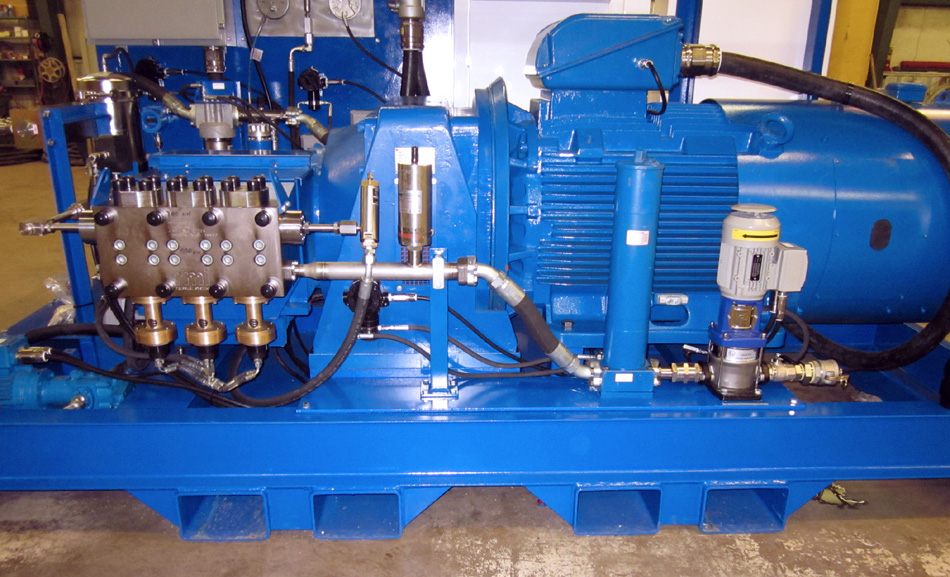Efficient Umbilical Testing Essential In Oil And Gas Sector
Within the Oil & Gas sector, the exploration of new and existing fields requires a large number of subsea structures, all of which need to be interconnected by umbilical systems

Trimax S250 High Pressure PumpWith the continuing trends in subsea to shore installations, and operations in deeper and deeper locations, umbilical systems have to cope with increased stresses. Mike Sherman, Marketing Manager at RMI Pressure Systems, looks at the testing of these systems and how to improve the efficiency and reliability of the umbilical installation process.
As the search for new oil and gas reserves continues, the extraction process is becoming more difficult, and the cost is increasing, which means that improved efficiency is more important than ever. The installation of new subsea structures requires them to be interconnected to provide the link from the host facility through which control is exercised, power is transmitted and utilities - such as injection chemicals - are supplied to the subsea wells.
The umbilical is a long, flexible construction - its length can be anything from a few miles to more than 180 miles - which consists of tubes, cables, armouring, fillers and wrapping all contained within a protective sheath. The multiple functions it performs and the demanding environment in which it is installed and operates, mean that the umbilical is necessarily a very hi-tech product which must perform reliably while in operation.
After manufacturing of the umbilical, it is flushed to remove any debris and filtered to a 3 micron level on a recirculating loop, then pressure tested to the designated pressure rating required (plus the safety factor). This process is often repeated prior to installation of the umbilical which may need to be pressure tested to ensure that it has not suffered any damage during transit from the manufacturer to the loading area. Once it has been lifted onto the pipe-laying vessel it is then necessary to monitor the umbilical while it is laid into position on the seabed. Finally, once the umbilical is in position, a full set of pressure tests need to be performed, many of which are in excess of 1,000 bar.
For these tests the engineers require a high pressure pump capable of generating pressures above 1,000 bar as well as high flow rates, above 50 litres/min, in order to minimise the time taken to carry out the tests. In addition, the system needs to have an excellent filtration package to ensure that the fluids used during the testing do not contaminate the umbilical pipes and actually flush out any contamination that may exist.
With the requirement for umbilicals to be installed around the world, the whole package must also fit inside a standard cargo container and allow for it to be lifted by a crane to ensure the most efficient use of this vital equipment. However, the most important issue in this list has to be proven reliability because the cost of any delays in this industry can have huge financial implications.
For the manufacturers of umbilicals, it is often more cost effective to operate an in-house testing capability, rather than outsourcing this critical aspect of the process. Working in this way also offers clients more flexibility as well as experienced engineers who have an excellent understanding of the product being installed and the test equipment being used to verify the final installation.
Once the umbilical has been installed and tested it can be put into full time production. However, there is still a requirement for periodic maintenance, pressure testing and cleaning; but now the test equipment will need to perform in an offshore environment. This requires it to be intrinsically safe; typically having to meet Class I, Div II classification for offshore use. By operating a test unit that meets these standards it can be used for both installation and servicing requirements.
Selection of a pressure testing rig that can perform multiple tasks can produce a reduction in the overall time required to fill, flush and pressure test the umbilical system. This in turn can reduce the cost of installation and commissioning. Such an investment has been shown to provide substantial savings in time to complete the testing and flushing operations, from 6 days down to just 2, giving the client a more efficient service.
RMI Pressure Systems has developed a range of products designed for this demanding environment and suitable for both onshore and offshore operation. Based around the proven design of the Trimax S250 high pressure pump and controlled by a Toshiba variable frequency drive (VFD), the test rig is designed to provide reliable and efficient service. Available with explosion-proof fittings and a nitrogen purge system, the latest developments of this test rig means it can perform in the most demanding situations.
The key to delivering greater efficiency when working with the lifelines of subsea structures is being able to rely on a test rig that can operate both onshore and offshore and also be capable of conducting all the essential tests. For further information on how RMI can help in designing and building an umbilical test rig - see contact details below
CONTACT
Michael Sherman
RMI Pressure Systems Ltd
msherman@armlink.com
www.rmipsl.com
+44 (0) 161 274 2451
Sunday 19 January 2014 / file under Oil | Gas | Engineering


